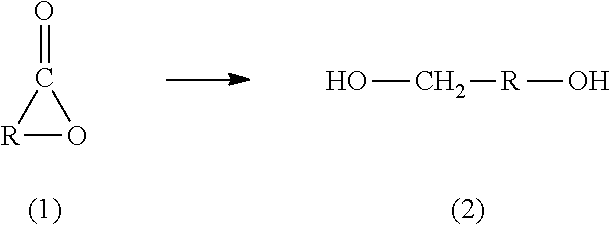Method for producing alcohol
a technology of alcohol and method, applied in the direction of catalyst activation/preparation, physical/chemical process catalyst, metal/metal-oxide/metal-hydroxide catalyst, etc., to achieve the effect of efficient and selective production, efficient and selective production of alcohol
- Summary
- Abstract
- Description
- Claims
- Application Information
AI Technical Summary
Benefits of technology
Problems solved by technology
Method used
Image
Examples
example 1 (
Preparation of Catalyst: Co-Impregnation Method)
[0103]0.0898 g of H2PtCl6 and 0.088 g of (NH4)6Mo7O24.4H2O were dissolved in 50 mL of water to prepare a solution; 1 g of hydroxyapatite (HAP, trade name “Tricalcium Phosphate”, available from Wako Pure Chemical Industries, Ltd.) was immersed in the resulting solution for 4 hours under room temperature (25° C.). After immersion, the hydroxyapatite was retrieved from the solution, and water was distilled off in a rotary evaporator under reduced pressure. This resulted in a powder. The produced powder was then calcined in an air atmosphere in a muffle furnace at 500° C. for 3 hours to prepare Catalyst (1) [Pt—Mo / HAP, amount of Pt supported: 4 wt. %, amount of Mo supported: 0.485 wt. %, Mo / Pt (molar ratio)=0.25].
example 2
[0104]1 mmol of β-Butyrolactone serving as the substrate, 100 mg of catalyst (1) [Pt that is 2 mol % of the substrate, Mo that is 0.5 mol % of the substrate, in terms of metal], and 3 mL of water were charged in an autoclave having a Teflon (trade name) inner cylinder and reacted at 130° C. for 12 hours under the condition of hydrogen pressure of 5 MPa to form reaction products. The conversion ratio (cony. [%]) of the substrate was measured using HPLC, and the yield of each one of the reaction products was measured using a gas chromatograph mass spectrometer (GC-MS).
examples 3 to 7
[0105]The same procedure as in Example 2 was performed except for changing the substrate, reaction temperature, and hydrogen pressure as described in the table below.
[0106]The results are summarized and shown in the table below.
TABLE 1H2temp.conversionproduct yieldEx.substrate(MPa)(° C.)(%)(%)25130>9935120>9945150>99551509165130>9975130>99
PUM
| Property | Measurement | Unit |
|---|---|---|
| Fraction | aaaaa | aaaaa |
| Fraction | aaaaa | aaaaa |
| Fraction | aaaaa | aaaaa |
Abstract
- metal species including M1 and M2; and
- a support supporting the metal species, and
- wherein
- M1 is rhodium, platinum, ruthenium, iridium, or palladium;
- M2 is tin, vanadium, molybdenum, tungsten, or rhenium; and
- the support is hydroxyapatite, fluorapatite, hydrotalcite, or ZrO2.
Description
Claims
Application Information
 Login to view more
Login to view more - R&D Engineer
- R&D Manager
- IP Professional
- Industry Leading Data Capabilities
- Powerful AI technology
- Patent DNA Extraction
Browse by: Latest US Patents, China's latest patents, Technical Efficacy Thesaurus, Application Domain, Technology Topic.
© 2024 PatSnap. All rights reserved.Legal|Privacy policy|Modern Slavery Act Transparency Statement|Sitemap



